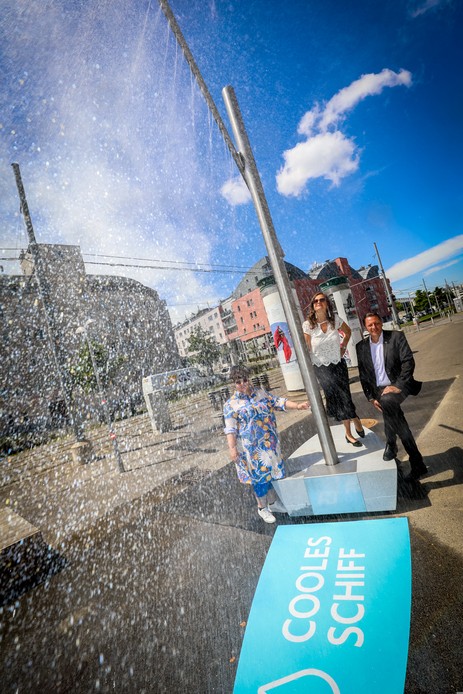Thessaloniki gets ready for its metro launch in November
The underground rapid transit lines have been under construction for almost two decades due to various project delays
 TheMayor.EU logo
TheMayor.EU logo 
Heat waves are becoming a normal part of life in cities and authorities are trying to tackle the persistent issue, Source: City of Vienna
Heat waves come to mind when thinking about summer in big cities. Vienna has been doing a lot to cool urban spaces and it all fits together
In the summer, cities get hot. All that concrete, asphalt and thousands of cars retain a lot of heat from the sun and radiate it back for hours into the night. In some cases, it can get so bad that according to the Czech Environmental Partnership Foundation, surface temperatures in cities can reach 70° C, more than enough to cook an egg.
Cities across Europe are trying a variety of methods to keep temperatures down and Vienna’s concept is an outlier when it comes to comprehensive planning and climate adaptation. The Austrian capital is a leader when it comes to climate change measures with nonstop initiatives, that cover everything from circular district heating projects to its own organic food brand.
But they also deal with climate adaptation measures, meaning, finding ways to mitigate the negative effects of climate change, like extreme heat. The city’s concept includes water spray systems, traffic calming, greening measures, as well as a more complex funding mechanism for adapting microclimates in Vienna’s districts. And all this is linked together on an app, called ‘Cooles Wien’ (Cool Vienna), which can help citizens find a place to cool off in the summer.
The app shows current temperatures around the city and helps guide citizens to cool areas, including parks, shady trees, mist showers and public bathing spots. These features are included on a digital map of the city and a bar offering weather forecasts.
Water is central to the cooling concept of Vienna, as there are still a lot of areas where there is a lack of city vegetation that can do the job naturally. This includes a smart cooling system in many public space, which creates a cool mist. The smart thing about it is that it uses the ambient temperature to turn on the tap and when temperatures drop, it turns off automatically.
This year, the city expanded this concept, as City Councillor Ulli Sima unveiled the new ‘Cool Ships’ (Cooles Schiff) – a water sprinkling system that produces a water curtain. The installations include a public sitting space and people who really need to cool down can just sit under the spray. It is also a bit of water-driven fun for the urban summer.

City Councillor Ulli Sima, testing out the Cool Shipsm, Source: City of Vienna
The Austrian capital has also launched numerous greening and traffic-calming measures across the city, with the motto "Get out of the asphalt" (Raus aus dem Asphalt). One example is Thaliastraße, in the heart of the 16th district. The popular shopping street is being redeveloped to feature 88 new trees and numerous perennial beds, water features and large-scale soil unsealing. This feature will have a significant impact on the local densely built-up district.
Local authorities have also launched the ‘Liveable Climate Model City’, which provides a fund of 100 million euros. The fund makes 25 million euros available to districts for climate adaptation projects until the year 2025, that are supposed to increase the quality of life in public spaces.

The underground rapid transit lines have been under construction for almost two decades due to various project delays

Now you can get your wine in Talence by paying directly in Bitcoin

That’s because the state has to spend money on updating the railway infrastructure rather than subsidizing the cost of the popular pass

Rethinking renewable energy sources for the urban landscape

The examples, compiled by Beyond Fossil Fuels, can inform and inspire communities and entrepreneurs that still feel trepidation at the prospect of energy transition

Now you can get your wine in Talence by paying directly in Bitcoin

The 10th European Conference on Sustainable Cities and Towns (ESCT) sets the stage for stronger cooperation between the EU, national and local level to fast track Europe's transition to climate neutrality.

At least, that’s the promise made by the mayor of Paris, Anne Hidalgo

The underground rapid transit lines have been under construction for almost two decades due to various project delays

At least, that’s the promise made by the mayor of Paris, Anne Hidalgo

Hostal de Pinós is located in the geographical centre of the autonomous region

Despite its church-y name, the district has long been known as the hangout spot for the artsy crowds

Urban dwellers across the EU are having a say in making their surroundings friendlier to people and the environment.

Forests in the EU can help green the European construction industry and bolster a continent-wide push for architectural improvements.

Apply by 10 November and do your part for the transformation of European public spaces

An interview with the Mayor of a Polish city that seeks to reinvent itself

An interview with the newly elected ICLEI President and Mayor of Malmö

A conversation with the Mayor of Lisbon about the spirit and dimensions of innovation present in the Portuguese capital














